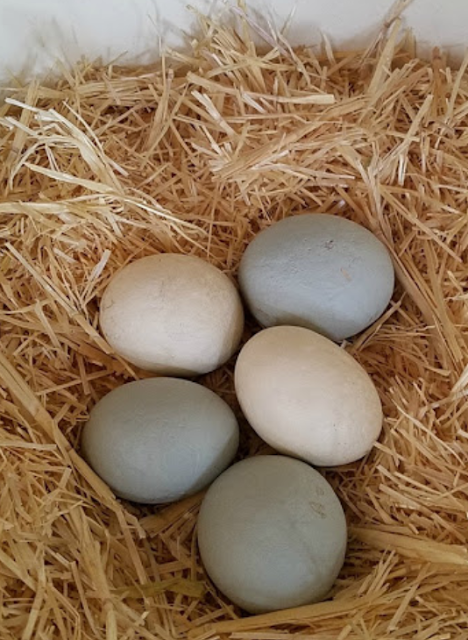This year I've been getting questions from lots of new chicken keepers asking how to get their chickens to lay their eggs in their nesting boxes.
It's been a weird year anyway, but what's up with this batch of 2020 chickens that don't want to use their nesting boxes?
If you have older chickens, they will usually teach the newcomers where to lay their eggs, but your first laying hens might need a bit of help figuring it out.
Why Nesting Boxes?
You might wonder why it's so important that your chickens lay their eggs in the nesting boxes. Well, the first and foremost reason is so you can find them! If your chickens start laying all over the place (especially if you free range them), there's a good chance you won't find the eggs.
Or at least won't find them before a predator does. Rats, snakes, skunks, and crows will all grab eggs if they can.
Eggs laid under bushes or shrubs, in the grass, in hay bales or random containers are hard to find. Even if you don't free range your chickens, if they start laying their eggs on the floor of the coop, the eggs can get stepped on and broken, tossed out with the coop bedding, or covered with poop.
So teaching your chickens to lay their eggs in their nesting boxes is important.
Check the Boxes
If your chickens are avoiding the nesting boxes, first of all be sure that they're "regulation", meaning the boxes should be about 12" cubed (12" tall, 12" wide and 12"deep). They can be at ground level or raised, but if they're up too high, you might need a ladder or ramp to help your chickens access them.
Check to be sure that snakes, mice or mites haven't taken up residence in the boxes. The presence of those pests can turn your chickens off from laying in the boxes.
If it's summertime, it could just be that the coop is too hot and your chickens are cooler laying in the shade somewhere outside. If that's the case, then it should be a temporary problem, although chickens do love their routines and it might be hard to break them of the habit of laying "al fresco".
If you are setting up your coop for the first time, make sure the boxes are positioned out of the way if possible. Hens like dark, secluded spots to lay their eggs.
And be sure you have one box for every three to four hens. Too few boxes can cause some of the hens to find somewhere else to lay their eggs instead of waiting for an open box, but ironically too many boxes can encourage your chickens to sleep in the boxes instead of using them for laying.
And that leads to poop in the boxes which leads to dirty eggs... That can also encourage poultry mites. So sleeping in the nesting boxes is a definite no-no.
Along those same lines, be sure that you provide enough roosting bars for your chickens. If they don't have enough space to roost, they might also be tempted to use the boxes to sleep in.

How to Get your Chickens to Lay Their Eggs in the Nesting Boxes
So how to get your chickens to lay their eggs in the nesting boxes? Here are some tips.
Soft Nesting Material
Fill the nesting boxes with nice soft nesting material. Pine shavings, straw, or my favorite aspen nesting pads are all good choices.
Keep the boxes filled with clean bedding, fluffing or replacing it as necessary to keep the boxes neat and tidy.
Fresh Herbs
Add some calming herbs to the nesting boxes. A calm hen is a happy hen.
Herbs like lavender, chamomile or lemon balm are all good choices. Toss in fresh herbs during the growing season and don't forget to dry some herbs to use when you don't have fresh.
Fake Eggs
Next, put some "fake" eggs in the boxes. Golf balls or ceramic eggs work, or even smooth rocks or stones roughly egg-sized.
I painted a few stones to match various egg colors (not that chickens really care). These fake eggs will teach your hens that's where they should lay their eggs too.
Once they have the hang of using the boxes, you can remove the fake eggs. And as I mentioned, after your first laying season, the older hens laying in the boxes should encourage the younger hens to use them as well.
Nesting Box Curtains
As I mentioned, chickens like private, dark spots to lay their eggs. Hanging curtains across the front of your nesting boxes can entice your hens to use the boxes.
Curtains can also help to encourage a broody hen if you're trying to get one of your hens to sit on eggs to hatch them.
Once you've made the nesting area as attractive to your hens as you can, be sure to make the "wrong" places your chickens have been laying in not appealing.
Cover or block any spots in which your chickens have been laying their eggs so they can't gain access. If you find a hidden nest, take the eggs, mess it up and disturb any nesting material they've gathered for that "illegal" nest.
As an aside, if you do run across a hidden nest of eggs and aren't sure if they're good to eat, just float them!
If your hens are sleeping in the boxes, go out to the coop after dark and remove them from the boxes and set them on the roosts. Remember that chickens can't see well in the dark, so once you've positioned them on the roosting bars with the others, they likely won't move back to the nesting box to sleep...at least that night.
Hopefully these tips will get your chickens to lay their eggs in the nesting boxes.
Pin This!
Further Reading









